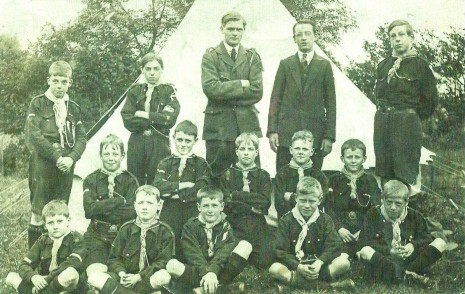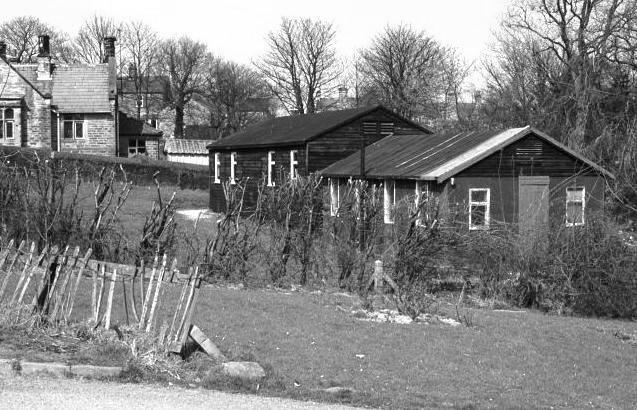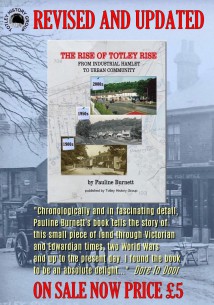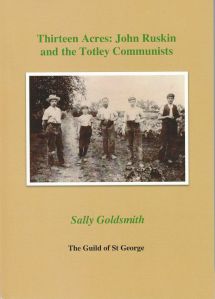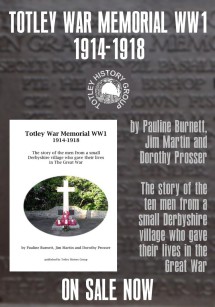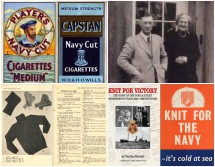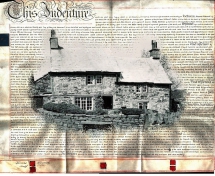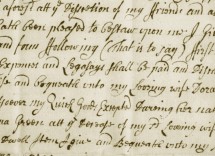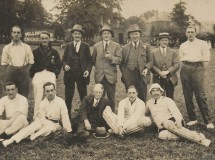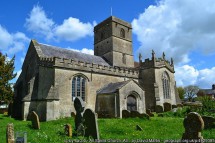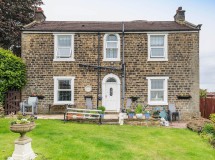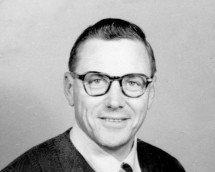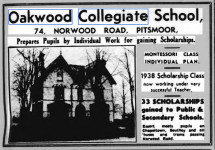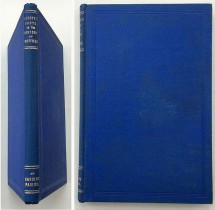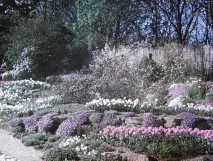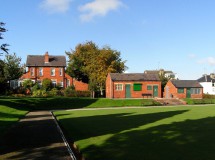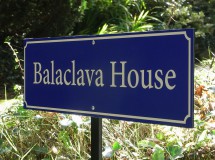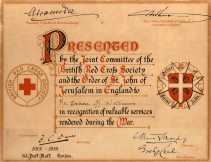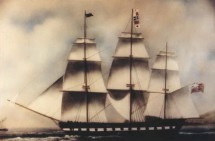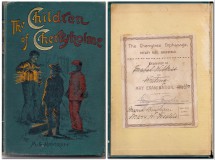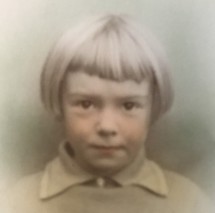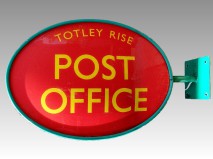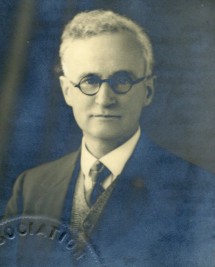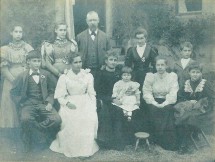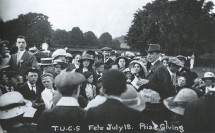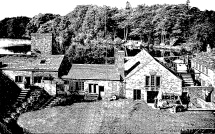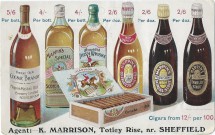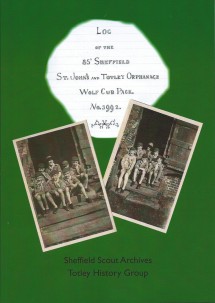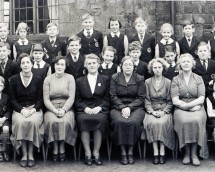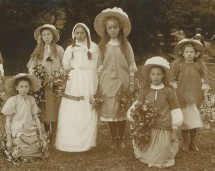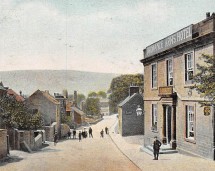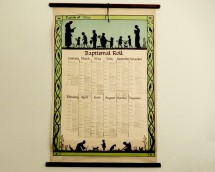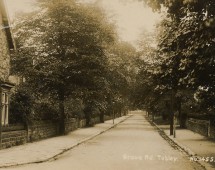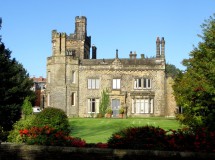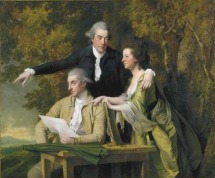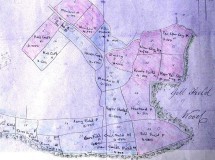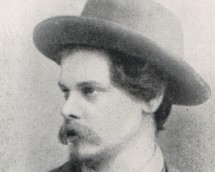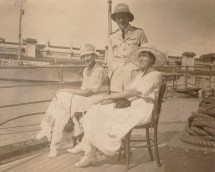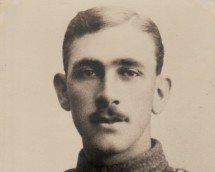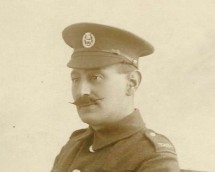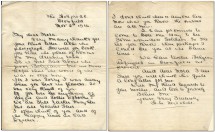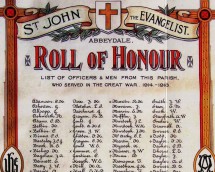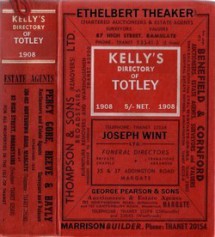A Little Scouting History
For two weeks during 1939 the Scouts from 85th Sheffield, St. John's, Abbeydale were enjoying their annual camp at Barmston, Nr. Bridlington. The boys enjoyed the usual camp activities of games, practical instruction, messing about, getting wet when it rained and sunburnt when the sun shone. They were only vaguely aware of the airplane target practice out over Bridlington Bay and the artillery exercises in the next field, and even when one of the younger assistant leaders received a letter to cut short his camp and report to the R.A.F. they were merely only sorry to see him go. It was not until their return back to Sheffield that they became aware of .the worsening international situation and the threat of impending war.
The Scout Troop had been formed in 1915 during the First World War meeting in various places until settling in Totley Orphanage until 1922, then the Old Laundry on Totley Rise until 1924, and eventually the old V.A.D. hospital, (now the post sorting office) next to St. John's Church.
Some of the first activities in which the Scouts were involved on formation were as orderlies at the St. John's War Hospital, collecting waste paper and. bottles, working on local farms and. participating in the War Savings Scheme.
Until 1944, when 1st Totley Scouts were formed, the 85th were the only Scout Troop in the area, 267th Dore being formed in 1949, and the 115th U.R.C. and 297th* Bradway much later during the 1960s.
On the outbreak of the Second World War the Scouts were again helping in many ways. In 1940 they collected 10 tons of scrap metal - with a value of £2, in addition to waste paper although this was difficult to dispose of. The collections were possible due to the loan of carts from a local firm of builders, Messrs Allen.
The Scouts were also involved in A.R.P. work acting as messengers and helping at their various displays and demonstrate.ions . This included instructing local people in the use of a stirrup pump in the case of incendiary bombs, and the best way to treat windows against blast damage.
Weekly Ambulance practice at Abbeydale Hall was helped along by Scouts volunteering as mock casualties and again in mock gas incidents on Mickley Lane.
In May 1940 the Scout Leader Dr. Mary Andrews was forced to resign due to her increasing involvement in Red Cross lectures and A.R.P. work in the Hope Valley where she lived. Dr. Andrews had been Scout Leader since 1919 and was succeeded by Les Broadbent briefly until his call up to the Army, and then by G.B. Smith.
At the same time the Scouts lost the use of the meeting place as the old hospital had once again been requisitioned for war use. Following hard work by the Scouts and Cubs, and donations from supporters, a wooden hut was found and purchased for £50.
This was a responsible feat at the time due to the shortage of wood and subsequently usually prohibitive price. In any event it was obtained only just before Government Timber Controls came into force.
In between their usual work the Scouts dug the foundations for the brickwork to support the hut which was to be sited behind St. John's Church. The project was eventually completed and officially opened on 12th October 1940 by the Lord Mayor, Councillor Luther Milner, who lived locally, and Rev. T.M. Archer the Vicar at St. John's. Sufficient ways around the food controls were found to provide tea and cakes inside the hut to those gathered.
At the time of the Sheffield Blitz in December 1940 the Scouts were out collecting blankets to deliver to the school rooms on Grove Road which was being used. as a rest centre for refugees. 'They were also out in the City Centre distributing food from the back of vans and lorries.
The Troop was to celebrate their Silver Jubilee on 15th December 1940 with a grand party and camp fire, but obviously this had to be postponed due to the blitz until the following February.
On 12th July 1941 Sheffield was visited by the Chief Scout, Lord Somers who had just been appointed on the death of the original Chief Scout and Founder Baden-Powell. To celebrate a display was put on by Scouts from all around the city in the Farm Grounds, Granville Road. The 85th Scouts were there demonstrating incendiary bomb fighting and first aid.
Throughout the war the Scouts undertook National Service by working on Longshaw Estate. Many weekends were spent trimming and felling trees, digging ditches and any other work as directed by the National Trust.
Some of the Scouts worked. with the Scout Service Bureau in local hospitals, and others as part of an Emergency Patrol.
On a lighter note towards the end of the war in 1945 the Scouts helped in Abbeydale Park serving teas ,selling programmes etc., on the occasion of a cricket match between an R.A.F. XI and Wally Hammond's XI.
Inevitably the war forced many changes in the Troop, with most at the senior Scouts and Leaders being called up to serve in many parts of the world. Very little traditional Scout work was possible due to the many other duties required, but throughout the period regular meetings were possible and at one time membership of the Troop had to be closed as there were too many boys.
Eventually on 1st September 1945 the Troop assembled at Dore and Totley station to board a train to their annual camp at Abney, Nr. Hathersage carrying their kit in the trek cart to enjoy seven days in a peaceful countryside doing what Scouts had done before the war, cooking their meals on fires, and generally having a good time.
July 1993
* Our thanks go to Andrew Jones, of the Sheffield Scout Archives for correcting an error in this unattributed article reproduced from Totley Independent Issue 165.
Dear Editor,
My main purpose in writing is to correct a mis-statement of history in the article 'A Little Scouting Hist,ory' in the July/August issue (of Totley Independent). There was a Scout Troop in Totley before the 1st Totley was formed at the end of the War - it was the All Saints Totley Scout Group attached to the Church and it's members formed the 1st Totley when the then Scout Master, Leslie Aubrey fell out with the Vicar, The Rev. J. Hutton. I'm not sure when the All Saints Totley Group was formed but it was going strong at the beginning of the war when I joined and kept going all through the War.
A number of camps were held in the second half of the War complete with camouflage nets and I well remember a very wet Patrol Leaders Easter Camp held at Millers Dale when, in utter frustration we took the train to Buxton and saw the film Haltes Castle with terrible thunderstorms on the screen and outside!
I'm sure other members of the All Saints Group will be writing to you to put the record straight.
Yours sincerely,
Edmund Short
P.S. Known as Shorty in my Scout days!
September 1993
I would like to correct a statement in the article 'A Little Bit of Scouting History' Jul/Aug issue, that the 85th. troop based at St. John's was the only troop in the area before 1944. I came to live in Totley in 1932 and joined (I think) the First Totley Scout Troup which had its headquarters at Totley Rise Methodist Church at the end of Grove Road. The scout master of the day was Ernest Jacques, one of the first war (1939-45) casualties from Totley.
One supposes this group lapsed during the war years and was reborn in 1944.
Just how long the troop was in existence before I joined I don't know, sixty years is a long time.
Mr. R. Peace
Bradway
More About The Scouts
As usual it was good to see the Independent this last week. Last Month's issue certainly aroused some comment over "All Saints" Scout Group and now as a founder member of it I would like to set the record straight.
It sprang from a Bible class held in the church room in 1931/2, run by Leslie Aubrey, developed into a boys club held in the old Mission room of All Saints Church. This created a lot of problems for the school and headmaster, Johnny Wood, became a little exasperated with us from time to time - particularly the disappearance of disciplinary equipment. Some of the parents felt they ought to help and suggested forming a Scout Group. Leslie Aubrey again obliged, went on instruction courses, and formed the 1st. All Saints Totley Scout Group in 1932. Eight lads were asked to form the nucleus of the troop, Jeff Salt, Ken Seals, Harry Bull, Alan Haywood, Frank Johnson and myself plus two names I cannot recall.
In retrospect, I think this caused a lot of ill feeling amongst those who were not chosen, but it soon disappeared when we had all passed our 2nd. class tests and opened membership to any lad over 11. We could not however continue meeting at the school, but after looking around for accommodation we found generous help from the Landlord of the Crown Inn. They had a wooden tea room, on what is now a car park, which they rented to us for half a crown (12.5 pence) a week. We were then able to leave all our equipment there in security. Cubs were later introduced, about 1935, led by Miss Kitty Rayton, assisted by my late brother Baron. A lot of hard work was put in by the scouts and their parents.
We came under the Chesterfield area until 1934/5 and in fact we won a competition in Chesterfield for Lady Baden Powell's Lion, of which we were justly proud. I vaguely remember 'Shorty," but I can never remember the troop at Totley Rise, hardly surprising after some sixty odd years. I believe the group carried on during the war years, but unfortunately when war was declared, the army commandeered our H.Q. and all its contents. I suppose if we had kept a Roll of Honour a few of the original troop would head it, Ken Seals, George Pulford, Ken and Vincent Webster plus more I cannot recall.
Yours sincerely
Bill Turner
October 1993
Totley All Saints Scouts Group
by Jo Rundle
Until 1933 there were no Scouts in Totley, the nearest group being 2 miles away at St. John's Church Abbeydale Road where Dr. Mary Andrews was the Scout Master. There was never any obvious interest from my two elder brothers, possibly because Totley village was very remote from the activities so far away or, because they knew that my Father was of the opinion that Scouts were the beginning of militarism, and would not allow them to join. Nor did I hear of any village boys who had the urge to join.
Then, in 1933, during a discussion with six 13 year-old boys at the end of a Sunday-school class in the 'Tin-tabernacle' room of All Saint's School, Lesley Aubrey, (Aubrey to those close to him), an enthusiastic and enterprising teacher, suggested that they should form a troupe of Totley Scouts. The first problem was a place to meet, and here, after a little negotiating with Mrs Milner of Totley Hall, they were offered the white-tiled old round kitchen at the base of the turret, which still contained the circular wrought-iron staircase that led to the large dining room above. Sadly three of the boys; Ken Seals, Vin and Ken Webster, lost their lives very early in the second world war, and the names of the other three elude me. However, the following extract from the All Saints Church magazine of January 1937 may threw some light on one of them, for the name of Johnson is mentioned, possibly indicating that this was John Johnson of Lanehead who was the same age and a friend of Jeff’s, perhaps someone will remember a friend or relative who was one of the other two originals.
With Aubrey as their Scoutmaster the troupe flourished, and in 1935 Jeff, now a King's Scout, had the great honour of representing Derbyshire at the St. George's Day Parade of Boy Scouts in the great Hall and Chapel at Windsor Castle. One of his proudest memories was his meeting with King George 5th an experience to be repeated in 1937 when he represented Derbyshire again at Windsor Castle, this time to meet the new King George 6th. Jeff was a dedicated King's Scout, and the family were very proud when he represented Derbyshire at the World Scout Jamboree in Scotland a year later; a week he said he would never forget with memories of the King moving freely amongst them and heartily joining in with their songs, as well as the many friends he made from all over the world.
The following is an extract from the Parish leaflet of All Saints' Church Totley in January 1937.
SCOUT GROUP
ROVER SCOUTS. The Commissioner is taking the necessary steps to license the formation of a Rover Scout Crew in connection with the Group. Thus will All Saint's Group be complete. A preliminary meeting of those interested will be held when an outline of Rovering will be given. Will any at all interested please send their names at once, either to the Vicar or Mr. Aubrey? They will then receive notice of the meeting. ‘The age limit is over 17’.
BOY SCOUTS. It is with mixed feelings that we report the resignation of A.S.M. Rawson. We look back on many happy times with him and recall his willing spirit to be of service at all times. Those of us who have been to camp with him know what a stalwart he was there. Mr. Aubrey loses a real supporter and adviser by his departure. We congratulate him on his appointment as Scoutmaster of St. Chad's Sheffield and wish him the best of luck and happiness in his new work. May we take this opportunity of thanking the many people who have helped two of our Scouts to raise funds for the Troup by joining their Christmas Club. It was nice to have a visit from our Brother Scouts of Our Lady and S. Thomas Troup recently when we had a most rollicking meeting together.
Troup Leader Jeffrey Salt gives weekly instructions to the Troup in Physical Training - passing on knowledge he gained at a special course for leaders in Chesterfield. We welcome Deric R Platt who comes to us from the Cubs. Johnson gains his 2 years star and Barr his first.
Wolf Cubs. The Cubs recently had a lantern lecture on their meeting night called "A journey to Switzerland" which contained some fine slides of the Rhineland and Switzerland. Interest was added by A.S.M. Balbernie who has recently visited these places & was able to illuminate things by his reminiscences. Thanks to the L.N.E.R. for the free loan of these l00 fine slides.
'CYMRY'
Perhaps someone reading this will know where the Totley Church Scouts met after Mrs. Milner left Totley Hall for Baslow, Jeff could only remember that it was a Hall somewhere, but where? and for how
long?. War was declared on September 3rd, 1939 and next morning Jeff volunteered for the R.A.F. depleting the Scouts of four of its founder members. My son Arthur was the Scribe to the Scouts in 1953
when the new Scout Hut in Hall Lane was opened by Mrs. Tozer of Totley Hall. This Group he says were the ‘1st Totley Scouts’ as today, but when were they founded? and what happened to 'Totley All
Saint's Scout Group?'.
Jo Rundle
December 2005
Totley Scouts
by Jo Rundle
There is so much speculation and interest in the first Totley Scouts that I think the following might be of interest. In 1930 a man called Aubrey formed a Scout Group when Mrs Milner allowed them to use the room under the Turret kitchens as their headquarters and my brother Jeff age ten was one of the first to enrol. They were a very dedicated group and by the time he was fifteen he had qualified as a King’s Scout and been invited on two occasions to attend Windsor Castle for special celebrations and later, after the death of King George the Fifth, to represent Derbyshire at the Jamboree held near the Scottish border in 1l937. Thousands of Scouts from all over the world gathered with the new King George 6th.when their singing and hand-slapping ‘Hands, Knees, and Upsa-daisies’ went with the rhythm.
Their Headquarters remained in the little kitchen and was quite adequate as they spent most of their time on manoeuvres in the little wood and in the stream. Then came the War in 1939 when Jeff and my next in line brother Geoff immediately volunteered, Elijah the eldest was not allowed as he was in a reserved occupation as the pattern maker of the moulds for making the complicated bricks that lined the kilns when special designs were called for.
No more Scouting was done until 1944 when, so far as England was concerned the war was over, although it continued in Germany until August 12th. 1945. My son Arthur lived with my parents from the age of 2 to the age of 7 whilst I was busy as a SJAB Sister at First-aid Post 13 Prince of Wales Road Darnall when we lived at Gleadless, but soon we were to leave when I bought a field next to the Leylands on Moorwood Lane and created a nursery garden. Our son was now 12yrs. old and had become a Totley Scout, when, I believe, Birley was the name of the Scoutmaster. It is obvious that Arthur had been the scribe for, many years later after leaving Grammar School, and spending four years at Durham University he spent the next eight years in Antarctica and it was during this time that I found the scribes book in a drawer in his room and noticing that it had not been used for so many years I took it to Totley and was advised to take it to a man called Carter, which I did, but, having arrived amid some sort of argument, he took it from my hand and threw it through an open door onto a sofa in an adjoining room. Nobody knows what happened to it since!!
I remember the wooden Scout-hut newly built just over the curb in the field that later was to be the site of the new College. It was to be officially opened the following day by Lady ? who lived in a very large house off Newfield Road, or Lane, Dore. The date 1946, College opened about 1952; I remember standing on Moorwood Lane with G.H.B. Ward and looking down on it when he said "It’s like a great big packing case".
October 2011
From J. W. Abson
I was in the Totley Scouts in 1938, before John Tinsdale and John Wood joined. Tinsdales took the grocers shop (run by Walter Evans at that time) at the top of Main Avenue. John Wood of course arrived in Totley when his father also John Wood came from Norton to be Headmaster at All Saints School. I remember him having a house built just before Main Avenue.
The Scout Master at that time was called Mr Aubrey. I believe his first name was Leslie and he lived on the Laverdene Estate. He was helped by another Rover Scout by the name of Epworth. The Scout Hut was in what is now the car park at The Crown Inn We used to go to camp some weekends in Farmer Kelk and Farmer Inkeringill fields both of Fanshawe Gate but as most of the scouts at that time were in the choir we had to be back to sing in the choir for the evening service at All Saints Church, otherwise the Vicar Rev Jerry Hutton would be rather displeased. There was also a Lady Akela for the cubs, I cannot recall her name but she lived down Main Avenue, near Baggy Parker, her brother was also in the scouts. I also remember going with the troop to Chesterfield Church for a special service and we walked there and back. It is pleasing to know that scouting in Totley is still going strong.
November 2011
From Richard Frost
A Happy New Year to everyone!
We are celebrating a centenary this year. The 85th Scout Group which started 100 years ago merged with the 215th only 13 years ago. We have put together a potted history of Scouting in Totley - which we think is correct!
Scouting first started in 1907 after the publication of the fortnightly magazine written by Baden-Powell called “Scouting for Boys”. The first Scout Troops in Sheffield were at Croft House and Darnall Church. Each Troop officially registered were given a number, in these cases 1st & 2nd Sheffield.
The first registered Troop in the Totley area seems to have been at Cherry Tree Orphanage in 1911, and was the 21st Sheffield. This was followed by the 42nd in 1914 and the 85th in 1915, so it seems that Scouting in Sheffield was becoming very popular. It is not known where the 42nd met until its close in 1922, but the 85th met first at St. Johns Church, Abbeydale Road and then, after the 21st combined with it in 1919, shared its time at the orphanage.
The 115th came along in 1919, based at the URC on Totley Brook Road. It closed in 1926 but was revived in 1962 and continues to this day.
1934 saw two Troops registered; the 209th at Totley Methodist and 215th at Totley All Saints. 209 th closed after a few years but the 215th continues now, based at the Scout Hut on Aldam Road. So for over 100 years now there has been at least one Scout Group continuously in Totley, and sometimes three. At 215th there are now over 120 boys and girls involved, aged 6 to 18 years.
If anyone has any further information or memories we would love to hear from you.
In 2015 we intend to celebrate this achievement in various ways, including a Centenary Camp in June for Beaver, Cubs, Scouts and Explorers, when we hope to have over 100 attending at a nearby camp site that we are taking over for the weekend.
Although we bought extra tents last year we will need to do so again this year in order to accommodate the growing number of children. We will use funds raised from our annual 20p challenge, as we did last year, to pay for the new tents. This involves giving each child a tube of ‘Smarties’, letting them eat the contents and then refilling with 20p's.
Lastly please take a look at our job advert if you are also interested in helping any of our sections. We have a growing number of men and women helping but we need more.
Richard Frost, Chairman, 1st Totley Scouts
TotleyChair@aol.com
0114 236 3603
February 2015
Search Our Website Here
September
October
November
Unless stated otherwise our meetings are held in Totley Library on the 4th Wednesday of each month at 7.30pm.
Pauline Burnett's book The Rise of Totley Rise has been revised and updated. It tells the story of this small piece of land from 1875 when there was only a rolling mill and chemical yard alongside the river a mile from Totley, through Victorian and Edwardian times, two world wars and up to the present day. It has 94 pages including a useful index and many illustrations from private collections. The book is available now from Totley Rise Post Office priced at £5, or through our website when an additional charge will be made to cover packing and postage.
A few copies are still available of Sally Goldsmith's book Thirteen Acres: John Ruskin and the Totley Communists. Totley was the site of a utopian scheme funded by art critic and social reformer John Ruskin. In 1877 he bought 13-acre St. George’s Farm so that nine Sheffield working men and their families could work the land and, to keep themselves busy, make boots and shoes. Sally tells an engaging story from our history with a quirky cast of characters including Ruskin himself, the poet and gay rights activist Edward Carpenter and Henry Swan, a cycling, vegetarian artist and Quaker. The book is available to order online from the The Guild of St. George by following this link.
A recently discovered box of WWII correspondence reveals the story of how a small group of ladies from Dore and Totley recruited knitters from the west of Sheffield and how their efforts made them the country's greatest provider of Comforts for the Minesweeping crews of the Royal Navy. The story is told in Knit For Victory, a new book from Totley History Group. Written by Pauline Burnett, it has 82 pages and many illustrations. It is on sale in local shops and via our website. Further information about the correspondence is in this inside page of our website: Dore & Totley Minesweeping Trawlers Comforts Fund.
The story is told in Totley War Memorial WW1 of the ten men from our village who gave their lives in the Great War. Written by Pauline Burnett, Jim Martin and Dorothy Prosser, a chapter is devoted to each of the soldiers with a family tree followed by as much information as could be discovered about the men and their families. There is also information about their military careers and the actions in which they lost their lives. The book has 64 pages and is illustrated throughout with photographs of the men, their families and the houses where they lived.
Totley All Saints' Church Parish Magazines for the years 1985-2006 with notices of baptisms, marriages and funerals and accounts of spiritual, educational, charitable and social matters in the village. Scanned in full, including advertisements from local traders.
In 1893 during the building of the Totley Tunnel there was an outbreak of smallpox amongst the navvies which spread to some of the local population. 17 people were buried in communal graves in Dore Churchyard, 6 from "Green Oak" (Lemont Road). The severity of the outbreak was principally caused by overcrowding and insanitary conditions in lodging houses .
Kathleen Grayson was a 39 year old housewife when WW2 broke out. She volunteered for the ARP and became an ambulance driver. During an air raid on Sheffield in July 1941, and despite her own injuries, she managed to get a seriously injured casualty to hospital. For this she was awarded a commendation from King George VI. Together with her friend Hilda Duffy, Kathleen also assembled a team of knitters to provide essential warm clothing for the men serving on the minesweepers patrolling the North Sea.
We have recently bought at auction the WW2 memorabilia of Douglas Platts whose family home was at Hillside, 98 Queen Victoria Road. After the war Douglas returned to his civilian occupation working in the family scissors manufacturing business. He lived in our area for the rest of his life.
We are very grateful to Mrs Valerie Taylor of Dore for lending us the title deeds to Lower Bents Farmhouse which is reputed to be the oldest surviving building in the area with a proven history back to 1621. We have now scanned and transcribed the deeds which could be particularly interesting to anyone with a connection to the local Fisher, Dalton and Marshall Families.
Until 1844, when Dore Christ Church parish was created, Totley township was part of Dronfield parish. We have now transcribed the burial records for former Totley residents at St. John the Baptist, Dronfield for the period 1678-1870 and at St. Swithin, Holmesfield for the period 1766-1901.
Whilst researching the history of the Dalton Family we found it useful to transcribe a number of early Wills and Inventories. These and those of many other Totley, Dore and Holmesfield people dating from between 1594 and 1856 have now been added to our website.
St. Swithin's Church, Holmesfield pre-dates Dore Christ Church and was the place where many of the people from Totley worshipped and were baptised, married and buried. Read the inscriptions on more than 750 gravestones in the churchyard including those of Mr. and Mrs. William Aldam Milner of Totley Hall, Jessie Matilda Tyzack (nee Fisher) of Avenue Farm, and Rev. J. A. Kerfoot of St. John's, Abbeydale.
Thomas Youdan was a music hall proprietor and benefactor who was living at Grove House, Totley in 1867 when he sponsored the first football knockout competition in the world for The Youdan Cup.
The words Millhouses Cricket Club can be seen in the background of team photos which are likely to date from between 1905 and the early 1920s, very probably pre-war. They were lent to us by Garth Inman who can identify his great uncle, Cecil Inman, in some of the photos and would like to know when they were taken and, if possible, the names of others present. Please take a look to see whether you can put names to any of the faces.
Josiah Hibberd was seriously injured whilst working on the construction of the Totley Tunnel in 1892. He died on 9 May 1897 at the age of 38 having apparently spent most of previous five years in hospital.
Bradway House was built around 1832 by Henry Greaves, a farmer, together with two adjacent cottages. We have traced most of the occupants of the property from these early days up to the start of World War Two.
We have transcribed the baptisms records at St. John the Evangelist, Abbeydale from when the church was consecrated in 1876 until just after the start of World War 1. The records are arranged in alphabetical order based upon the child's name and show the date of baptism, the names of the parents, their home location and occupation.
Nick Kuhn bought an original 1920s poster which had this owners' blind stamp in one corner. The stamp almost certainly refers to a house named Wigmore that was built in the late 1920s or early 1930s. The first occupiers that we can trace are John Howarth Caine, a district mineral agent for the LNER, his wife Florence Jane (nee Prince) and daughter Doris Mary. The Caine family lived at Wigmore until 1936 by which time the house would have been known simply as 12 The Quandrant.
George Griffiths died on 13 December 1888 following an explosion during the sinking of number 3 airshaft at Totley Bents. His widow Florence died shortly afterwards and his two daughters Maud and Annie were adopted separately. Whilst Annie lived the rest of her life in Yorkshire, Maud emigrated to Australia in 1923 with her husband, John Burrows, daughter Margaret and son Jack, pictured above.
George Wainwright was said to have been born in Bamford, Derbyshire in 1714. He learned the trade of linen weaving and moved to Totley after his marriage on 1744. He became an ardent follower of John Wesley who paid many visits to Sheffield and who would have passed through or close to Totley. Preaching was at first conducted out of doors and when Wesley's preachers became harassed by a mob of Totley ruffians in 1760, George offered them safety of his own home. He remained a Methodist for all of his long life, dying in Dore in 1821 at the reputed age of 107.
Oakwood School was started by Mrs Phoebe Holroyd in 1925 initially as the Firth Park Kindergarten and, by 1927, as the Firth Park Preparatory School. Phoebe was still working at the school almost fifty years later when she was well into her seventies. We would like to hear from anyone with memories of the school.
James Curtis was born at sea aboard HMS Chichester in 1790. He enlisted as a Private in the 1st Grenadier Regiment of Foot Guards in Sheffield in 1812 and served in Spain and Portugal during the Peninsular War. He later fought in France and Belgium taking part in the Battle of Waterloo. In later life James lived at the Cricket Inn where his son-in-law William Anthony was the licensed victualler. He died in Heeley in 1882 aged about 91.
Charles Paul lived in Totley in later life. He was a local historian and archaeologist who was an authority on the history of Sheffield, especially the two areas he knew best: Attercliffe and Ecclesall. His books and letters to local newspapers were published under the Latin form of his name Carolus Paulus.
Towards the end of the 19th century Totley Hall gardens became a well known beauty spot that attracted many hundreds of visitors from Sheffield on open days and the rock gardens became one of its most popular features. Mrs Annie Charlesworth sent us six glass transparencies of the rock gardens taken, we believe, in the early years following the Great War.
Anton Rodgers send us photographs of three water-colours that had been bought by his grandfather at a sale of the contents of Abbeydale Hall in 1919. One was of a scene said to be in York by A. Wilson. A second was of a seated child with a dog believed to be pianted by Juliana Russell (1841-1898). The third was of Lake Como, by Ainslie Hodson Bean (1851-1918) who lived for much of his life on the Riviera and in North Italy.
A Canadian correspondent sent us photographs of a set of silver spoons that were bought in a small town in British Columbia. The case contained a note signed by Ebenezer Hall indicating that they were a wedding gift to Maurice and Fanny Housley. We think we may have traced how they got to Canada and where they might have been since.
Green Oak Park was opened on 23 March 1929 on land that had been bought by Norton District Council from John Thomas Carr, a farmer and smallholder of Mona Villas. In later years, the buildings were used by the Bowling Club (the green having been built in 1956) and by the park keeper. However, the buildings appear to have been constructed in several phases, the oldest of which predates the park to the time when the land was used for pasture.
We believe the old Totley Police Station at 331 Baslow Road was built around 1882. Two lock-up cells were excavated just below floor level in the summer of 1890. We have traced the Derbyshire Constabulary police officers who lived there from John Burford in 1886 to George Thomas Wood who was there when Totley was absorbed into Sheffield in 1934.
David Stanley lived in Totley Rise in the later years of his life. Born in Bulwell, Nottinghamshire, he joined the 17th Lancers when he was 19 and rode in the Charge of The Light Brigade at the Battle of Balaclava where he was seriously wounded. For the first reunion of veterans in 1875, he told his story to a reporter from the Buxton Herald.
This picture postcard was addressed to Miss Abell, Holly Dene, Totley Brook Road and posted in Rotherham on 10 December 1907. Edith Annie Abell was born on 4 February 1887 in Sheffield and her family came to live in our area in the 1900s, staying for the rest of their lives.
Charles Herbert Nunn enlisted in the British Army on 23 August 1915 and was sent to France on 18 December 1915 to served with the British Expeditionary Force. In March 1916 it was discovered that he was underage and he was returned home. Shortly after his 18th birthday he re-enlisted and was again posted abroad where, in addition to this trio of medals, he was awarded the Military Medal.
This certificate was awarded jointly by the Red Cross and St. John's Ambulance to Isaac Henry Williams, of Lemont Road, for his services during WW1 as a stretcher bearer. We are seeking anyone who can help us pass it on to a living relative.
In 1832 Samuel Dean pleaded guilty to stealing a quantity of lead from the Totley Rolling Mill and was sentenced to seven years transportation to Australia. He sailed on the Mangles and upon arrival in New South Wales he was sent to work for William Cox, the famous English explorer and pioneer. After receiving his Certificate of Freedom in 1840, Samuel became a farmer and went on to have a very large family. Samuel was born in Whitechapel around 1811 to parents Samuel Dean Snr. and Susannah Duck. His descendant Sarah Dean would like help in tracing his ancestry.
Ellen Topham was born in 1889 in Nottingham. Her parents had been living together since 1862 but had never married so it was most unusual that, after their deaths, Ellen was accepted into Cherrytree Orphanage. Even more so since her father, Snowden Topham, had been acquitted somewhat unexpectedly in a widely reported manslaughter trial. Ellen remained at Cherrytree until her death from pulmonary tuberculosis at the age of 15.
Mabel Wilkes was a resident in Cherrytree Orphanage between 1897 and 1905. Her granddaughter Sally Knights sent us these images of a book presented to Mabel as a prize for her writing. Sally also sent us some personal memories of her grandmother and a photograph of a locket which contains portraits of Mabel and her husband Septimus Gale.
John Henry Manby Keighley was living at Avenue Farm when he enlisted in 1916. He fought in France with the Cheshire Regiment but after home leave in early 1918 he went missing. The Army were unable to determine whether he had deserted or returned to the front and been either killed or captured by the enemy. In August 1919 he was formally presumed killed in action but it appears he did not die but returned home to his family.
Horace Ford was admitted to Cherrytree Orphanage on 26 October 1888 at the age of six. He left at the age of 14 to become an apprentice blacksmith and farrier. Soon after his 18th birthday Horace enlisted in the Imperial Yeomanry to serve his country in the war in South Africa. His letter home to his Orphanage mentor tells of the lucky escape he had in battle.
Pat Skidmore (née Sampy) lived on Totley Brook Road from 1932 to 1948 before her family moved to Main Avenue. In this short article she remembers her time at Totley All Saints School where she was a contemporary of Eric Renshaw and Bob Carr.
As we have nowhere to exhibit memorabilia and artifacts, we have created a Virtual Museum instead. The latest addition to our collection is this double-sided Totley Rise Post Office oval illuminated sign which was on the wall of 67 Baslow Road before the Post Office business transferred to number 71. Please contact us by email if you have things that you own and would like to see added to the virtual museum.
Conway Plumbe was a man of many talents who came to live in Totley Rise around 1912. As a young man he had poems published by Punch magazine and is remembered in modern collections of WW1 poetry. A number of his paintings were accepted by the Royal Academy. An engineering graduate of London University, he joined the Civil Service where he rose to a high level as a factory inspector, publishing two books on the subject and giving a series of talks on workplace health and safety on BBC radio during WW2. In retirement he wrote a philosophical-spiritual work called Release From Time.
Inside Totley Rise Methodist Church there is a Roll of Honour commemorating the soldiers from its congregation who served their king and country during the Great War. For all but one of the 28 names the soldier's regiment is recorded in the next column. The exception is David Cockshott for whom 'killed in action' is written alongside yet he appears on no war memorial in our area and no record of a mortally wounded soldier of that name is to be found. We think we have solved the mystery.
Mrs. Kate Plumbe moved from Mansfield to Totley Rise with a number of her family in 1913 and became closely involved with the Totley Union Church. Her daughter Winifred became a missionary and headmistress in Calcutta for over 38 years following which she returned home to live with her sister Hilda on Furniss Avenue. Hilda had also been a teacher, missionary and, like her mother, a volunteer at St. John's VAD during WW1.
Thomas Glossop was a cutler and razor manufacturer who was well known amongst cricketing and gardening circles. Despite going blind, he was able to continue his hobbies with remarkable success
The Totley Union Cycling Society Prize Giving and Fete was held on the fields near Abbeydale Hall on 18 July 1914. Anne Rafferty and Gordon Wainwright have named some of the people in two wonderful photographs of the event. Can you identify any more for us?
The Tyzack family are well known in our area for owning iron and steel trades at Walk Mill, Abbeydale Works, Totley Rolling Mill and Totley Forge. This article covers the history of the family from the late 18th century when William Tyzack the founder of the company was born until the early 20th century when Joshua Tyzack farmed at Avenue Farm, Dore.
Walter Waller Marrison moved to Totley around 1897 with his wife and their two young sons. He was a house builder who constructed properties around Totley Brook and Greenoak before ill health forced him to take up less physically demanding work. In 1904 he took over the tenancy of the grocers and off licence at number 71 Baslow Road. After his death in 1908, his widow Kate and later their eldest son Jack continued to run the business until it was sold in 1934.
Ron Wijk of Nieuw-Vennep in the Netherlands has sent us two scanned images of drawings of old cottages made by the celebrated Dutch painter, Anton Pieck (1895-1987) simply annotated "Totley", and wondered whether we could identify their locations.
We would like to thank Christopher Rodgers for bringing to our attention this fascinating log of the 85th Sheffield (St. John's and Totley Orphanage) Wolf Cub Pack for 1927-45. The log is published jointly by Sheffield Scout Archives and Totley History Group as a free PDF download. It is illustrated by no fewer than 92 photographs and is supported by a comprehensive index and biographies of some of the main participants.
Following our Open Meeting event on School Days, Roger Hart, Howard Adams and John Timperley have each written to us with their memories of Norwood School, which was located in the rooms attached to the Dore & Totley United Reformed Church on Totley Brook Road.
On 22nd July 1909 the children of Dore and Totley Schools celebrated by a pageant the union of England under King Ecgbert which took place at Dore in AD 827. The pageant was devised and written by Mrs Sarah Milner and her daughter Marjorie and performed in a field close to Avenue Farm in front of a large audience. Photographs of the event survive together with a fragment of the script.
John Edward Greenwood Pinder had lived all 46 years of his life in Totley but on census night, Sunday 2 April 1911, he was not at home; he was in Derby Gaol serving a sentence of three months hard labour. From the age of 20, John had been in and out of local courts for a series of minor offences including drunkenness, assault, wilful damage and night poaching. Finally he was sent to gaol for cutting down and stealing 86 small trees which he sold in Sheffield market for Christmas.
We have already transcribed the census returns for Totley, Totley Rise and Dore. Now we have transcribed Census Strays. These are people who were born in Totley but are missing from our earlier transcriptions. They may have been living, working or studying elsewhere or just away from home on the night the census was taken. Two people were in prison. Others were in Union Workhouses, hospitals and asylums. Fully indexed strays from the 1851, 1861, 1881, 1891, 1901 and 1911 censuses are available now.
We wish to thank Gillian Walker for allowing us to digitize an archive of material about the 1st Totley Scout Group. Most of the material was collected by Arthur Percival Birley in the period 1949-51 and there are many interesting documents pertaining to the building of the scout hut on Totley Hall Lane. In addition four Newsletters survive, two from the 1940s and two from 1971.
We are grateful to Angela Waite and All Saints' Parish Church for giving us access to baptismal and kindergarten birthday rolls dating from 1926 to 1941. We have transcribed the names, addresses, birthdates and baptismal dates and created an alphabetical index of entries for you to search.
Edmund Sanderson, a Sheffield estate agent, aquired the land on either side of the old drive to Totley Grove in 1874 and divided it into plots for development. He called it the Totley Brook Estate. But before many houses were built, the estate road was severed in two by the building of the Dore & Chinley Railway line. The eastern end of the road became the cul-de-sac we now call Grove Road.
John Roberts was born in Sheffield in 1798. He became a partner in one of the leading silversmiths firms in the city before moving to Abbeydale Park in 1851 and extending the house in Victorian gothic style. He paid for the building of St. John's Church and was believed to dispense more in charity than any other person in the neighbourhood including his protege Ebenezer Hall.
The Coke Family owned the Totley Hall Estate from 1791 to 1881. With the aid of a family tree to guide us, Josie Dunsmore takes us through the story of their tenure.
When the Rev. D'Ewes Coke inherited the Totley Hall Estate in 1791 it had two farms. Josie Dunsmore tells the story of how the two farms were combined under the tenancy of Peter Flint with the aid of field maps drawn by Flint himself and later by the Fairbanks family.
Do you think you recognize this face? More than sixty photographs of the girls and teachers at Hurlfield Grammar School for Girls in the 1940s were given to Totley History Group by Avril Critchley, who was herself a student at the school. The collection includes fifteen form photographs from June 1949. There would have been a number of girls from the Totley area attending the school in those days.
Christine Weaving tells the story of her 2 x great uncle George Edward Hukin, a Totley razor-grinder, and his life-long friendship with the academic, poet, writer, and free-thinker Edward Carpenter.
Eric Renshaw (pictured here on the right with Bob Carr) grew up and lived in Totley from 1932 to 1960. Many of his memories are of a sporting nature.
We are very grateful to Gordon Grayson for giving us this splendid sale document for the Norton Hall Estates, following the death in 1850 of Samuel Shore. The estates included a large part of Totley and the document has maps and illustrations, plus schedules of land and property with the names of tenants. We have also added a transcription of the entries for Totley and Dore.
Watch this Youtube video of the talk given by Dr. Mark Frost and Sally Goldsmith on Ruskin, Totley and St. George's Farm. The talk was hosted by Totley History Group on 20th May 2015 as part of the Ruskin in Sheffield programme. Also enjoy a video of the outdoor performance Boots, Fresh Air & Ginger Beer written by Sally.
When Jacqueline A. Gibbons became interested in what made her father tick, it began a journey through WW1 archive records and led to her flying from Toronto to visit the house and village where he lived and the countryside that he so much enjoyed. Jacqueline reminds us that in the early 20th century Sheffield was a driving force of industry and that Totley was the place where many of its remarkable people lived and where they formulated their ideas.
Edgar Wood was the designer of The Dingle, 172 Prospect Road, built in 1904 for Rev. William Blackshaw, the founder of the Croft House Settlement. The house, together with its western terrace and boundary walls, has now been awarded Grade II listed building status.
What was probably "the most perfect little garden railway in existence" in 1910 was to be found in the grounds of Brook House, Grove Road, the home of its designer and constructor, Guy Mitchell. Look at some wonderful photographs and read reports in newspapers and a full appreciation in Model Railways magazine.
We have now completed our transcription of Totley School's Admission Records for the period from 1877 to 1914. There is also a useful index to the names of the scholars and to their parents or guardians. We are very grateful to Sheffield Archives and Local Studies Library for allowing us to transcribe and publish these records and for permission to reproduce the photograph of a specimen page of the register.
On 8, 9 and 11 November 2014 Totley History Group held an exhibition at Dore & Totley United Reformed Church to commemorate the centenary of the First World War. Below are additional links to some of the photographs we were lent and stories we researched especially for the exhibition.
Oscar Creswick was a local farmer who served with the Army Service Corps in Salonika and who after the war returned to Totley to become the innkeeper of the Cricket Inn and a member of the village's successful tug of war team.
Walter Evans was a market gardener who also ran a small grocery shop on Hillfoot Road when war broke out. He fought with the Machine Gun Corps at the fourth battle of Ypres. After the war, Walter ran a grocers shop at the top of Main Avenue.
Fred Cartwright was another Totley soldier who survived the Great War. He fought in France and Belgium and although he wasn't wounded he was gassed and was home on sick leave when his daughter was delivered by Nurse Jessop during a snowstorm in January 1917.
Maurice Johnson joined the Yorkshire Dragoons, a territorial unit, on 1 Jan 1914 and so was called up at the very start of the war. He fought throughout the war on the Somme, at Ypres and at Cambrai. After demobilization in 1919 Maurice returned to his old occupation in the steel industry.
Bill Glossop lent us a letter written by his father, William Walton Glossop to his wife describing life in the army during training in the north east of England and asking her to keep him in mind with the children.
The photo above provides a link to an album of photographs taken of WW1 Hospitals at St. John's, Abbeydale and the Longshaw Estate.
Nora Green, of Chapel Lane, was only 14 when war broke out. In 1914 she was ill with diphtheria and was sent to the isolation hospital at Holmley Lane, Dronfield. Nora recovered and wrote a letter of thanks to one of the hospital staff and the reply she received survives.
We have collected together on this page the names of local men who appear on various War Memorials and Rolls of Honour in Totley, Dore, Abbeydale, Norton, Holmesfield and Dronfield.
Unfortunately we were unable to identify all the photographs we were lent of Totley Soldiers. Please take a look at this album to see if you recognize any of the missing names.
This walk visits locations that have strong associations with Totley during the First World War. It includes the homes of the ten soldiers from the village who lost their lives, the auxiliary hospitals, war memorials, and even the rifle range on which the soldiers trained. Take a look at the first draft of a new walk by the authors of "Totley War Memorial WW1 1914-1918"
We wish to thank the Trustees of Cherrytree for giving us permission to publish transcriptions of the Cherrytree Orphanage Admissions Book entries for the years 1866-1929. There is also an alphabetical index for you to look at.
With more people having access to faster broadband and mobile networks, we have uploaded seven full and unedited oral history recordings and also added more short excerpts for you to listen to.
Our transcriptions of local trade directories have been expanded to cover the 95 years from 1837-1932 and have also been indexed. From the days when there were a handful of farmers, stone masons, saw handle makers & scythe grinders to the wonders of the Totley Bridge Garage Company, Betty's Boudoir and The Heatherfield Shopping Centre.
We continue to add to our Totley Newspaper Archive. Recent entries have included several about The Plumbe Family, Thomas Glossop and accidents during the construction of Totley Tunnel.
Totley Church of England Parish Magazines for the years 1922-1939 and 1948-1967 with notices of births, marriages and deaths and accounts of spiritual, educational, charitable and social matters in the village.
Around 90 photographs taken by Stuart Greenhoff for his thesis A Geographical Study of Dore and Totley including several of Totley Moor Brickworks. Superb!
Chronologically ordered snippets of information recorded by Brian Edwards during his many years of research into our local history.
Read the inscriptions on more than 700 gravestones in the churchyard.
Visitors since 24 Sep 2012:


